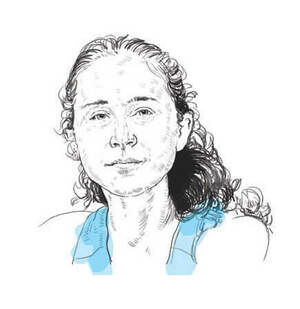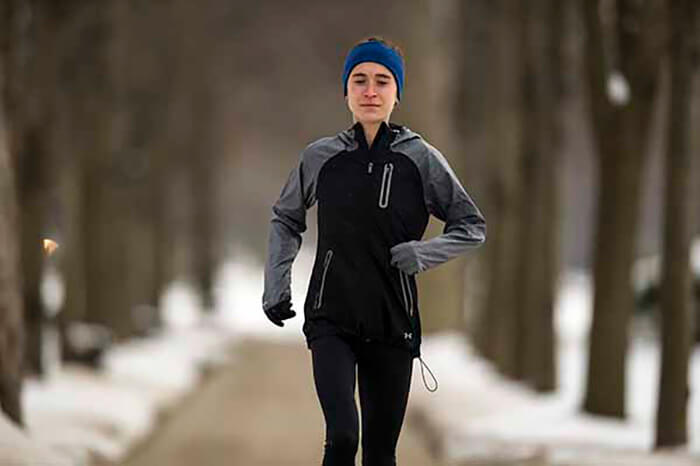
Marathons are weird. In no small part because classical lore tells us the first person to complete one dropped dead at the finish line. Racing 26.2 miles in less than 150 minutes requires runners to repeatedly tug at loose threads in the fabric of time without unraveling their dreams.
Newly minted Olympic medalist Molly Seidel ’16, who won bronze this past summer in Sapporo, Japan, clocking a time of two hours, 27 minutes and 46 seconds, believes the marathon’s distortion in space-time — with apologies to Einstein — involves special relativity. “Time just moves differently when you’re running one of those races,” she says. “It’s like . . . in some ways, those first 16 miles go by in an instant. And then other times, a quarter of a mile seems like forever.”
Seidel’s journey from high school sensation to four-time NCAA champion to the first American medalist in the women's marathon since 2004 defies logic. The 27-year-old pro qualified for the 2020 Tokyo Games the first time she ran in a competitive marathon, and she medaled in her third go-round at the distance. For the uninitiated, that doesn’t happen. Like, ever.
In the 20 months prior to her stunning race to the podium, the public narrative about Seidel underwent a dramatic transformation. In a wide-ranging interview on Julia Hanlon’s Running on Om podcast in January of 2020, Seidel detailed her decade-long struggles with and treatment for anxiety, depression, OCD, disordered eating and the unabating mental stress of competing at her sport’s highest levels. Headlines cast Seidel as an outspoken mental health advocate for female athletes.
All of this occurred more than a year before gymnast Simone Biles removed herself from competition in Tokyo and recast the mental health discussion throughout international athletics.
The truth is, Seidel remains conflicted about her elevated profile in this dialogue, and sees herself as a reluctant messenger on the topic.
“I think people assume I’m a lot more comfortable talking about it than I am,” she says. “I didn’t necessarily come to be viewed as an advocate by choice. I had spoken about it at a time when I was just on a friend’s podcast. It was before the Trials. Before I became widely known on Instagram. But a lot of people just ran with it, and it’s become a lot more than before. Once you talk about it, it kind of becomes your entire story. I think that’s why a lot of athletes worry about opening up about how mentally difficult it is to compete at this level.”
What happened on August 7 at Odori Park in Sapporo might well keep that storyline in the foreground for Seidel. Then again, it might eclipse it. The moment bronze dangled from her neck, Seidel became the only American woman to win a national high school title, collegiate championship and an Olympic marathon medal in her sport.
The pressure isn't going anywhere. But know this: Molly Seidel refuses to allow her past pain or her ongoing recovery to define her as a competitor.

The Plan: Have No Plan
Before her breakout, runner-up performance in the U.S. Olympic Trials, Seidel characterized her chances of qualifying for Toyko as “kind of a moonshot.” By the same token, medaling in Japan was highly unlikely, even after she shook up the American distance-running scene in Atlanta at the end of February. But that was 2020.
A reprieve of 70 weeks, along with consistently good physical health during training, turned the “moonshot” metaphor on its head. Seidel’s end game took on much loftier expectations.
That physical well-being piece can’t be understated. From 2014 through 2018, Seidel endured a conga line of injuries. Mold-induced respiratory illness, a stress fracture of her right tibia and fibula, a pelvic fracture, a partially torn Achilles tendon in her left heel and a thoracic fracture of her T5 and T6 vertebrae, to name the most serious. The bulk of them were the result of her unconscious food restriction, which led to low bone density. Three years ago, she spent six months in rehab after her first season as a pro — a consequence of bone graft surgery to repair a non-union of her pelvis break.
COVID pivots at this year’s Games proved to be a new sort of hurdle. Athletes were required to quarantine inside their hotels except for training, which took place on an abandoned, 400-meter speed skating track made of concrete. Seidel’s coach, Jon Green, was delayed en route to Sapporo due to shifting Japanese travel protocols.
Marathon events for the 2020 Games had been moved 500 miles north of Tokyo to the Japanese prefecture of Hokkaido to avoid Tokyo’s withering August heat. Despite this arrangement, unseasonably high temperatures were forecast for race day and, just 10 hours before showtime, the start time was moved up. Seidel’s wakeup call backpedaled from 4 a.m. to 3 a.m. for a six o’clock starting gun. “There’s no other way to put it, the lead-up to that race was a hot mess express,” she says.
Not that any of that threw her off. Seidel’s longtime racing m.o. is to expect the unexpected. “I don’t go in with a plan because inevitably, things don’t play out that way,” she says.
The only thing that stayed on script was the heat. Full sun, 78 degrees, 83-percent humidity.
“The majority of the population doesn’t have the anxiety issues she does,” says Matt Sparks, 48, Seidel’s coach at Notre Dame and today a close confidant. “Race variations are just a drop in the bucket for her. It doesn’t raise her heart rate. Everyone else is trying to figure out how they’ll acclimatize to the heat and the earlier start time, but her focus is elsewhere. She’s overcome so many obstacles in life that running in heat isn’t that challenging by comparison. Adverse conditions are her forte.”
In the hours preceding the race, there were other odd deviations from the norm. Perpetually self-effacing and a deft deflector of praise, Seidel called her twin brother and sister and told them that she “could make things interesting” if conditions were right. Her message to her parents was even more pointed. She said she was going to “go for it” and that she saw “no point in just going out and being happy to be here.”
Stranger still, as she packed her knapsack before dawn on race day, Green, her steadfastly levelheaded coach, urged her, “just in case,” to include her formal Team USA whites, intended only for medal ceremonies.
“It’s funny because I think if the Olympics had been held on schedule, my outlook would have been different,” Seidel says. “But I’d had such strong training and, with the marathon, the competitive margins are so tight. I knew if the conditions were right, I was capable of medaling.”
For his part, Green, also 27, calls her medal run “not expected, but not surprising.”
Hey Jude
The footage of Seidel’s final 50 meters on the course, replete with her jabbing a finger at the powder blue USA lettering on her chest, pointing to the heavens and expelling three primal screams of “yes,” are indelible. The other 42,114.2 meters were just as dramatic.
Surprised to be among the frontrunners early in the race, Seidel drew much-needed reassurance at the sight of an adjacent teammate, experienced marathoner and 2012 Olympic track medalist Sally Kipyego. Mile 13 brought a gut check. A runner in the lead group made a push just as Seidel slowed at a water station. “I actually lost contact with the pack and fell off (their pace),” she recalls. “I really had to focus and tell myself: ‘Stay calm, but get back in it. You need to stay on this train.’ It would’ve been a much harder race if I hadn’t caught up with them.”
The final stages of the race were full of white-knuckle momentum swings for Team Seidel. First, 2019 world marathon champion Ruth Chepng’etich of Kenya dropped out of the race in the 19th mile. Mind-boggling. Next, Seidel was leading the field with seven miles to go, but four miles later, at 2:10:39, Israeli runner Lonah Chemtai Salpeter broke with two Kenyans, who ultimately finished 1-2, and the American’s dream was suddenly on life support.
“When Salpeter passed me, I was pretty convinced I was going to get fourth, but I really made a push to catch her,” says Seidel. “And then, she was just gone from my field of vision. I didn’t realize that she had started walking (severe cramping ultimately relegated Salpeter to 66th place). I thought she could still be there, but that’s when it got real for me. Like, ‘You’re in it and if you hold it together, you’re getting a medal.’”
It has since been oft-reported that in the stretch run of the race, Seidel repeatedly mouthed words of a prayer to Saint Jude, a favorite of her mother, Anne, a Saint Mary’s College graduate who discovered it inscribed inside Notre Dame’s grotto. I place myself in your care at this difficult time. Help me know that I need not face my troubles alone.
The mantra served Seidel well at the time, and it may also help deliver her moving forward. She plans to run the New York City Marathon on November 7.
“My battle with mental health issues has given me a constructive amount of distance from the sport — I’m much more OK at dealing with things as they come,” she says. “Things might be a bit more difficult because my brain chemistry prevents me from feeling a hundred percent all the time, but I’m just going to make the most of it. Running is my entire life, but it’s not worth sacrificing my long-term health or my morals for. I don’t think it’s necessary to have a win-at-all-costs mentality in order to have success. I think you have to hold onto things a little more loosely. But don’t get me wrong. I’m fiercely competitive. I’m a friggin’ shark.”
And sharks must move to live.
Chad Konecky is the National Director of the Gatorade Player of the Year program. His multimedia portfolio includes on-air coverage of the NFL, NCAA sports radio play-by-play and a half-decade at both ESPN and USA TODAY. He has reported in corporate sectors associated with aerospace, defense, design, automotive safety, LEED, the movie industry and the developing world. His print media portfolio includes assignments in politics, business, technology, medicine, transit, the arts, cultural history, education and law enforcement.